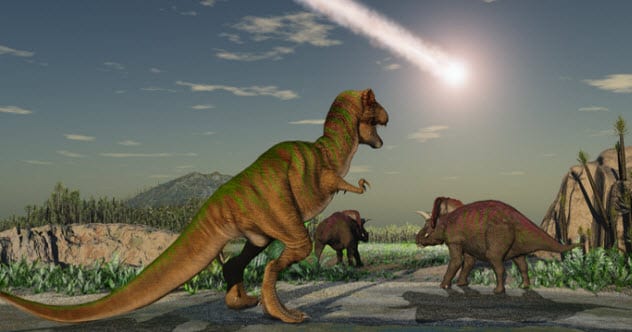Now Reading: 10 Times Scientists Were Absolutely Sure… and Absolutely Wrong
-
01
10 Times Scientists Were Absolutely Sure… and Absolutely Wrong
10 Times Scientists Were Absolutely Sure… and Absolutely Wrong

Throughout history, science has pushed humanity forward with bold theories and groundbreaking discoveries. But not every idea stands the test of time. Some once-revered scientific theories turned out to be wildly wrong—revealing not just the limits of human understanding, but also the importance of skepticism, experimentation, and humility in the pursuit of truth.
From phantom particles and poisonous air to cooling worlds and invisible cosmic substances, here are 10 scientific theories that were so confidently accepted—and so spectacularly wrong—they remind us just how strange and ever-changing our quest for knowledge truly is.
Related: 10 Insane Conspiracy Theories About the World We Live In
10 Global Cooling: The Ice Age That Wasn’t
Whatever happened to GLOBAL COOLING?
In the early 1970s, a combination of short-term temperature declines and changing atmospheric data led to headlines warning of an imminent new ice age. In 1975, Newsweek published an article titled “The Cooling World,” suggesting that global cooling could threaten food production and destabilize nations. This alarm was partly fueled by a genuine observed cooling trend in the Northern Hemisphere from the 1940s to the 1970s, caused by increased postwar industrial air pollution reflecting sunlight away from Earth.
However, while certain climatologists examined potential cooling scenarios, the majority of peer-reviewed climate research at the time was already identifying warming trends driven by rising carbon dioxide. Later analyses found that only a small minority of studies focused on cooling, while most projected temperature increases. The media, captivated by the “ice age” narrative, amplified these minority reports, embedding the myth in public memory for decades to come.
Today, climate change skeptics often point to the global cooling scare as evidence of scientific flip-flopping. In reality, it was a cautionary tale about misinterpretation and selective reporting—not a reflection of scientific consensus. Modern climate science, based on vastly improved models and decades of data, overwhelmingly confirms that global warming—not cooling—remains the planet’s greatest environmental threat.[1]
9 Cold Fusion: Too Good to Be True
Fusion Energy: Hype or The Future?
In March 1989, electrochemists Stanley Pons and Martin Fleischmann stunned the world by announcing they had achieved nuclear fusion at room temperature in a tabletop experiment. Their process involved passing an electric current through heavy water (deuterium oxide) with a palladium electrode, claiming it produced excess heat unexplained by chemical reactions alone. If true, this breakthrough would revolutionize energy production, offering unlimited clean power without radioactive waste.
The announcement sparked an immediate global frenzy. Laboratories across the world rushed to replicate their results, only to find results that couldn’t be reproduced. Within months, the scientific community declared cold fusion unverified and fundamentally flawed, concluding that Pons and Fleischmann had misinterpreted experimental noise and measurement errors as revolutionary energy output. The original experiment lacked essential controls, and their refusal to share all data further undermined credibility.
Despite mainstream science dismissing cold fusion, a small group of researchers continues to explore low-energy nuclear reactions under different names, arguing that the concept warrants reexamination with modern tools. Yet the original cold fusion saga remains a sobering lesson: extraordinary claims require extraordinary evidence, and science advances only when experiments are transparent, reproducible, and rigorously scrutinized.[2]
8 N-Rays: France’s Imaginary Radiation
The N-Ray Debacle: How Expectations Can Cloud Your Judgment
In 1903, French physicist René Blondlot believed he had discovered a new type of radiation, which he named N-Rays after his home city of Nancy. He claimed these rays could increase the brightness of objects and even penetrate materials that blocked visible light. Soon, over 100 papers were published on N-Rays by French scientists, many describing experiments demonstrating their effects. The discovery was hailed as a major addition to the already exciting era of X-rays and radioactivity research.
However, the scientific community outside France was skeptical. American physicist Robert W. Wood traveled to Blondlot’s lab to investigate. During a demonstration, Wood covertly removed an essential prism from Blondlot’s apparatus without him noticing. Despite the missing component, Blondlot still reported seeing N-Rays, exposing the phenomenon as an experimental illusion driven by observer bias and expectation rather than objective physical phenomena. Wood published his findings, and within months, interest in N-Rays collapsed.
The N-Ray saga is often cited in textbooks as a classic example of confirmation bias in science, where researchers see what they expect to see rather than what is actually present. It also underscores the importance of external verification in experimental science, reminding physicists that enthusiasm for discovery must always be tempered by rigorous skepticism.[3]
7 Luminiferous Aether: The Substance That Wasn’t There
How Luminiferous Aether Led to Relativity
Before Einstein’s theory of relativity, scientists believed that light waves, like sound waves, needed a medium through which to travel. This hypothetical medium was called the luminiferous aether, an invisible substance thought to fill all space. The concept was deeply embedded in 19th-century physics, providing an explanation for how light could propagate through the vacuum of space.
In 1887, physicists Albert Michelson and Edward Morley conducted a landmark experiment to detect the Earth’s motion through this aether. Using an interferometer to measure slight changes in the speed of light due to Earth’s orbit, they expected to find evidence of aether drag. Instead, their results showed no variation whatsoever, indicating that light’s speed was constant regardless of Earth’s movement. This puzzling null result confounded scientists.
It wasn’t until Einstein published his special theory of relativity in 1905 that the mystery was resolved. His equations showed that light does not require a medium to travel through space, eliminating the need for aether entirely. The aether concept was swiftly discarded, demonstrating how a single revolutionary theory can collapse centuries of established scientific belief almost overnight.[4]
6 Phlogiston Theory: Fire’s Imaginary Essence
This IMPOSSIBLE Theory Led to the Discovery of Oxygen
In the 17th century, European scientists sought to understand why things burned. They proposed the phlogiston theory, which claimed all flammable materials contained an element called phlogiston released during combustion. Ashes were thought to be the material’s residual form left behind after phlogiston escaped, explaining why wood or coal left residue when burned. This theory elegantly fit observable patterns and became deeply entrenched in early chemistry.
However, as experiments grew more precise, inconsistencies emerged. Metals burned to form heavier substances (metal oxides), contradicting the idea of mass loss through phlogiston release. In the late 1700s, French chemist Antoine Lavoisier conducted meticulous experiments proving that combustion actually involves combining with oxygen, not releasing a mysterious substance. By weighing gases before and after combustion, he showed mass was conserved differently than phlogiston theorists believed.
The fall of phlogiston theory marked a revolution in science, laying the foundation for modern chemistry and the concept of conservation of mass. It also demonstrated a key lesson in scientific history: even widely accepted, “logical” theories can be overturned by rigorous measurement and the willingness to discard beautiful but false ideas.[5]
5 Caloric Theory: Heat as a Fluid
James Joule Biography: The Beer Brewer Who Changed The World
In the 18th century, scientists believed heat was a weightless, invisible fluid called caloric that flowed from hot objects to cold ones. This theory explained why touching hot metal burned your skin—caloric was supposedly transferred from the object into your body. It also justified the warming of substances by friction, as caloric was thought to be squeezed out like liquid from a sponge.
The theory faced major challenges in the early 19th century, particularly through the work of Benjamin Thompson (Count Rumford), who noticed that endless heat could be generated by boring cannons. If heat were a finite fluid, repeated drilling should have used it up—but it didn’t. James Joule later conducted experiments demonstrating that heat was actually a form of energy produced by motion. He measured the precise relationship between mechanical work and heat, establishing the foundation for thermodynamics.
By revealing heat as kinetic energy—the movement of particles—rather than a mysterious fluid, scientists radically changed their understanding of engines, electricity, and the behavior of matter itself. The caloric theory’s downfall became a triumph of experimental physics and marked a turning point into the modern energy age.[6]
4 Steady-State Universe: The Eternal Cosmos
Eternal Universe: The New Theory that Might Change the Way we Think About the Universe
In the mid-20th century, astronomers grappled with a fundamental question: did the universe have a beginning? While the Big Bang theory proposed a single explosive origin, the steady-state theory—championed by scientists like Fred Hoyle, Hermann Bondi, and Thomas Gold—argued that the universe had no beginning or end. Instead, it was constantly expanding while creating new matter to keep its density constant. This elegant idea avoided the philosophical challenge of an initial cosmic creation event.
For a while, steady-state and Big Bang theories competed on relatively equal footing, with observations of cosmic expansion able to support either interpretation. However, in 1965, scientists Arno Penzias and Robert Wilson accidentally discovered the cosmic microwave background radiation, a faint glow permeating the universe. This radiation was exactly what Big Bang cosmologists predicted: leftover heat from the universe’s hot, dense origin billions of years ago. Steady-state theory, which didn’t predict such a relic, could not explain this finding.
The discovery of cosmic background radiation led most cosmologists to abandon the steady-state model in favor of the Big Bang. While the theory still exists in modified fringe forms, its decline highlighted a core principle of science: no matter how philosophically appealing an idea is, it must yield to observational evidence.[7]
3 Expanding Earth Hypothesis
The EXPANDING EARTH THEORY
Before plate tectonics became universally accepted, geologists were puzzled by how continents seemed to fit together like puzzle pieces. One theory that gained traction in the early 20th century was the Expanding Earth hypothesis, which proposed that the planet itself was increasing in size, pushing continents apart as its surface area grew. Advocates argued this explained why continents drifted without requiring oceanic crust subduction or complex tectonic boundaries.
However, as global seafloor mapping improved in the 1950s and ’60s, scientists discovered clear evidence of plate tectonics and subduction zones, processes that recycle Earth’s crust and drive continental movement without requiring the planet to swell. Additionally, precise satellite measurements found no increase in Earth’s diameter over time, definitively ruling out expansion. The expanding Earth idea fell out of scientific favor, though a few fringe proponents persist today.
The downfall of this theory reinforced geology’s commitment to integrating physics, satellite geodesy, and field data, establishing plate tectonics as one of the most powerful unifying theories in science. It also serves as a reminder that grand, intuitive ideas must still match hard measurements to survive in scientific discourse.[8]
2 Miasma Theory of Disease: Bad Air Kills
For centuries, doctors and scientists believed that diseases like cholera, plague, and malaria were caused by miasma—poisonous, foul-smelling air rising from rotting organic matter. This theory originated in ancient Greece and persisted well into the 19th century. Entire public health policies were built around miasma, leading cities to prioritize removing garbage and improving drainage to eliminate foul odors.
Ironically, these sanitation efforts sometimes did reduce disease—not because they removed toxic air, but because they eliminated breeding grounds for pathogens and waterborne contamination. However, the core concept of miasma was fundamentally wrong. In the mid-to-late 1800s, scientists like Louis Pasteur and Robert Koch demonstrated that microorganisms—bacteria and viruses—cause most infectious diseases, giving rise to germ theory and modern microbiology.
The collapse of miasma theory revolutionized medicine, public health, and epidemiology. It shifted focus from vague atmospheric fears to tangible, controllable agents of illness, saving millions of lives through hygiene, sterilization, and vaccination. This dramatic pivot showed how scientific progress often requires rejecting deeply entrenched beliefs, no matter how “common sense” they seem.[9]
1 Spontaneous Generation: Life from Nothing
Spontaneous Generation vs. Abiogenesis. What’s the difference?
For nearly two thousand years, it was widely believed that life could arise spontaneously from nonliving matter. Aristotle proposed that maggots appeared from rotting meat, frogs from mud, and mice from piles of grain and rags. Even in the Renaissance, great minds like Jan Baptista van Helmont claimed that dirty laundry plus wheat grain could produce mice within 21 days. The theory seemed intuitively correct, as insects and small creatures reliably emerged from decaying environments.
In the 17th century, Italian scientist Francesco Redi challenged spontaneous generation by proving that maggots only appeared when flies laid eggs on meat, not from the meat itself. Yet the idea persisted until the mid-1800s when Louis Pasteur conducted his famous swan-neck flask experiment. He showed that sterilized broth remained free of life unless exposed directly to microbes in the air, proving that life arises only from existing life—a principle known as biogenesis.
Disproving spontaneous generation transformed biology and paved the way for germ theory, cell theory, and modern medicine. It revealed how deeply entrenched beliefs—even those seemingly backed by daily observation—can be shattered by careful experimentation, redefining humanity’s understanding of life itself.[10]
fact checked by
Darci Heikkinen




















